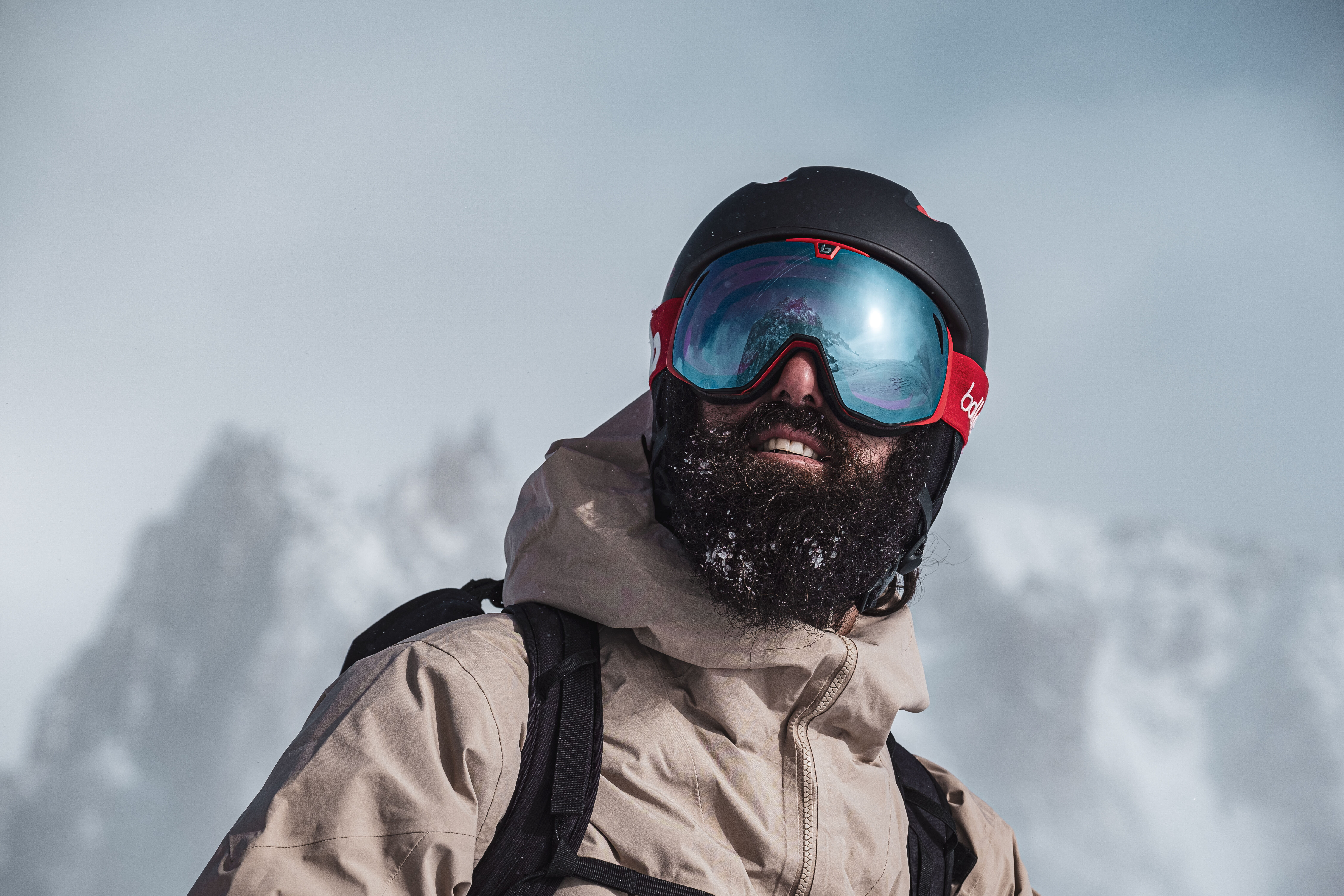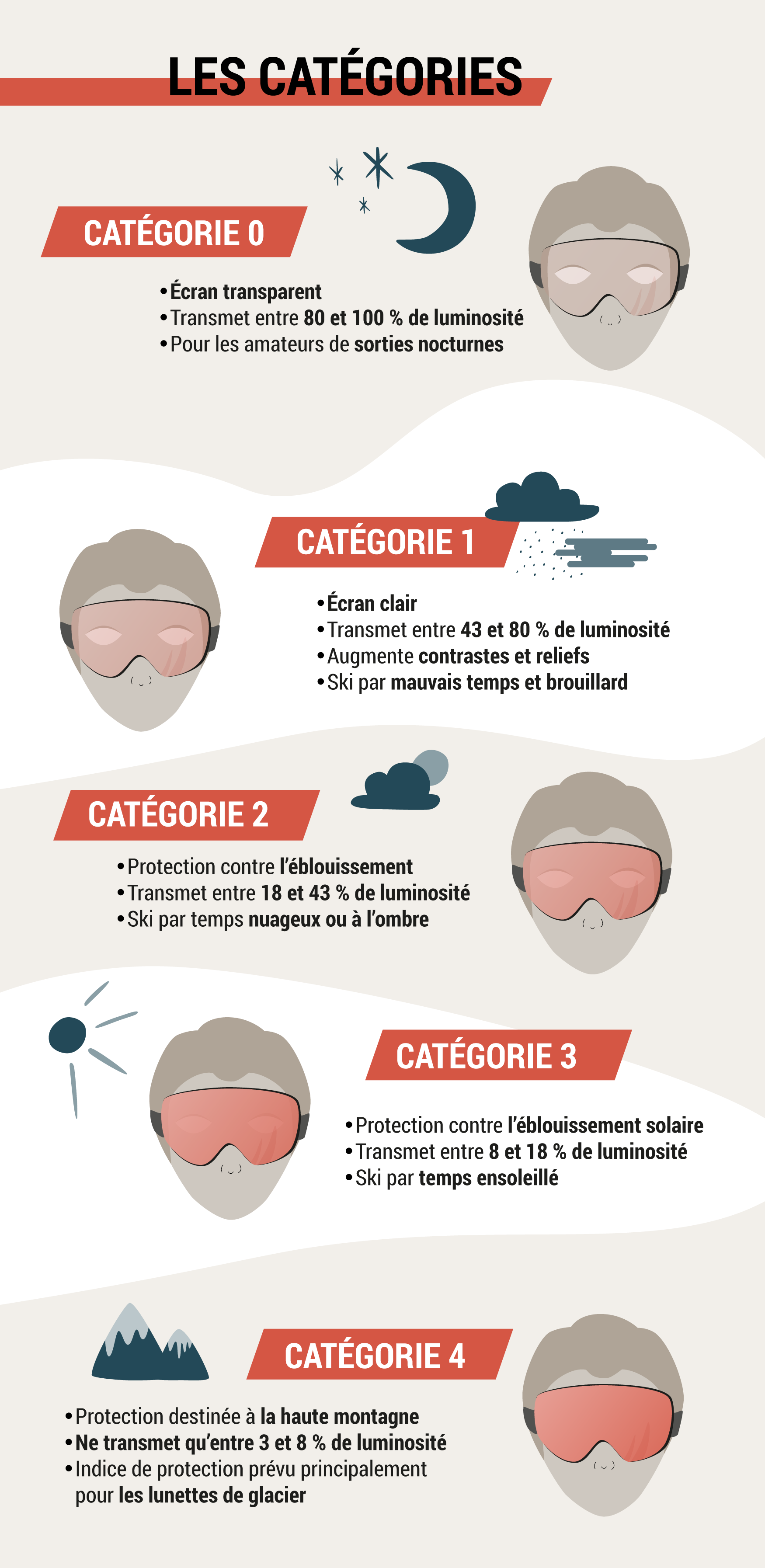WIE WÄHLT MAN SEINE SKIBRILLE AUS?
09. Dezember 2021 / 8 Minuten Lesezeit
Gute Skibrillen schützen Ihre Augen vor UV-Strahlen und garantieren Ihnen eine optimale Sicht bei gutem und schlechtem Wetter. Ihr Masque bietet Ihnen außerdem hervorragenden Komfort bei Wind, Kälte oder Schneefall. Wie wählen Sie Ihre Skibrillen aus? Welche Kriterien sind zu berücksichtigen?

DIE VERSCHIEDENEN OPTISCHEN QUALITÄTEN VON SKIBRILLEN
Gute Skibrillen schützen Ihre Augen vor UV-Strahlen und garantieren Ihnen eine optimale Sicht bei gutem und schlechtem Wetter. Ihr Masque bietet Ihnen außerdem hervorragenden Komfort bei Wind, Kälte oder Schneefall. Wie wählen Sie Ihre Skibrillen aus? Welche Kriterien sind zu berücksichtigen?
+ SCHUTZINDEX UND KATEGORIE
Um Ihre Skibrillen auszuwählen, ist es wichtig zu wissen, unter welchen Bedingungen Sie fahren möchten: nur bei gutem Wetter? Bei schwierigen Wetterbedingungen? In großer Höhe? Obwohl alle Skibrillen 100 % der UV-Strahlen filtern, lassen nicht alle die gleiche Lichtmenge durch. Je nach Wetterbedingungen haben Sie daher unterschiedliche Bedürfnisse. Deshalb werden Skibrillen in Solarkategorien eingeteilt. Diese 5 Kategorien geben die Menge des gefilterten Lichts an.
- Kategorie 0: Transparente Bildschirme. Sie lassen 80 bis 100 % des Lichts durch und sind für den Abend / die Nacht gedacht.
- Kategorie 1: Helle Bildschirme, die eine gute Sicht bei bewölktem Wetter ermöglichen. Sie übertragen zwischen 43 und 80 % der Helligkeit und ermöglichen so eine Erhöhung der Kontraste und Reliefs. Ideal zum Skifahren bei schlechtem Wetter und Nebel.
- Kategorie 2: Bietet einen guten Schutz gegen Blendung, indem sie zwischen 18 und 43 % der Helligkeit zulässt. Diese Bildschirme ermöglichen es Ihnen, bei bewölktem Wetter oder im Schatten Ski zu fahren. Sie eignen sich auch für sonniges Wetter, wenn Sie nicht zu lichtempfindlich sind.
- Kategorie 3: Ideal für einen Skitag bei gutem Wetter, da sie effektiv vor Sonneneinstrahlung schützt. Diese Bildschirme lassen nur 8 bis 18 % des Lichts durch, um an sonnigen Tagen in Ruhe Ski zu fahren.
- Kategorie 4: Ist für hochalpines Gelände wie Gletscher gedacht. Diese Bildschirme lassen nur 3 bis 8 % Helligkeit durch, um extremen Schutz zu gewährleisten, und sind nicht für allgemeines Skifahren gedacht. Dieser Schutzfaktor ist selten für Skibrillen vorgesehen und muss Gletscherbrillen vorbehalten bleiben.

+ BEHANDLUNGEN DER BILDSCHIRME
The screens of ski goggles benefit from numerous treatments to bring you maximum comfort and performance during your outings in the mountains.
- Polarisierende Behandlung: Sie wird bei allen Skibrillen der Kategorie 3 und bei bestimmten photochromen Bildschirmen angewendet. Sie erhöht die Kontraste und reduziert Reflexionen. Die polarisierende Behandlung bietet echten Sehkomfort und eine hervorragende optische Definition.
- Anti-Beschlag-Behandlung: Sie wird nach der Herstellung auf die Innenseite des Bildschirms aufgetragen und ist unerlässlich, um das Beschlagen Ihrer Skibrillen zu verhindern. Diese Behandlung ist heute bei allen Skibrillen vorhanden – die überwiegende Mehrheit von ihnen ist zudem mit einem Doppelbildschirm ausgestattet, um das Auftreten von Beschlag zu begrenzen. Um den Halt der Anti-Beschlag-Behandlung zu gewährleisten, wird empfohlen, die Innenseite der Skibrillen nicht zu reinigen, wenn sie nass ist, um die Behandlung nicht zu beschädigen.
- Verspiegelung (Mirror): Dies ist nicht nur eine ästhetische Wahl. Der Spiegeleffekt schützt Ihre Augen vor der Blendung durch die Sonne, die durch die Reflexion auf dem Schnee verursacht wird. Die auf Skibrillen aufgetragene Spiegelbehandlung kann verschiedene Farbtöne aufweisen. Bei Modellen der Kategorie 1, die für schlechtes Wetter geeignet sind, ist die Spiegelbehandlung oft transparent. Bei Skibrillen der Kategorien 2 und 3 können Sie je nach gewünschtem Stil mehr mit den Farben spielen.
- Anti-Kratz-Behandlung: Sie schützt den Bildschirm Ihrer Skibrillen vor Kratzern.
DER KOMFORT DER SKIBRILLEN
Bei der Wahl Ihrer Skibrillen sollten Sie auf die Elemente achten, aus denen sie bestehen, da jede Skibrille anders ist.
+ DIE STRUKTUR
Die Struktur der Skibrillen besteht aus einem Rahmen, einem Bildschirm, Schaumstoffen, einem Belüftungssystem und einem Band (Strap). Von Modell zu Modell kann jedes Element unterschiedlich sein.
+ DER RAHMEN
Der Rahmen bezeichnet den Umriss Ihrer Skibrillen. Es gibt drei verschiedene Rahmentypen.
- Fullframe: Der Rahmen ist sichtbar und umschließt den Bildschirm.
- Frameless: Rahmenlos; dieser Typ hat keinen sichtbaren Rahmen und der Bildschirm deckt die gesamte Struktur ab. Dies bietet ein maximales Sichtfeld.
- Semi-frameless: Auf halbem Weg zwischen Fullframe und Frameless gibt dieser Typ dem großen Bildschirm den Vorrang und lässt den Rahmen nur leicht erscheinen.
+ DIE BILDSCHIRMFORM
Es gibt zwei Formen von Bildschirmen.
- Sphärisch: Sphärische Bildschirme sind um eine Kugel herum aufgebaut. Sie haben eine gewölbte, abgerundete Form. Sie bieten eine hervorragende optische Sicht und gute Belüftung, sind jedoch teurer.
- Zylindrisch: Flachere Bildschirme bieten ein großes horizontales Sichtfeld und einen Vintage-Look. Sie sind flexibler und kostengünstiger, aber weniger effizient bei Luftstrom und optischer Präzision.

+ DER SCHAUMSTOFF
Der Schaumstoff ist der Teil, der mit Ihrer Haut in Berührung kommt. Skibrillen können aus einlagigem, zweilagigem oder dreilagigem Schaumstoff bestehen. Es ist ratsam, einen Schaumstoff mit hoher Dichte zu wählen, da dieser sich besser an die Gesichtsform anpasst. Der Belüftungsschaum an den Rändern ist weniger dicht, um das Beschlagen zu verhindern.
+ BELÜFTUNG
Wie bei einem Helm ist die Belüftung bei Skibrillen wichtig. Diese wird durch Lufteinlässe in der Struktur und Schaumstoffe oben und unten ermöglicht. Das System sorgt für Luftzirkulation gegen Beschlag, ohne Kälte einzulassen.
+ DAS BAND (STRAP)
Das Band bezeichnet das Kopfband. Es bietet Optionen wie einfache Verstellung und Silikon-Antirutschstreifen.
AN DIE PRAXIS ANGEPASSTE SKIBRILLEN
-
Skibrillen mit Einzelschirm: Mit einem Bildschirm der Kategorien 0 bis 4. Kategorie 1 und 2 sind am weitesten verbreitet (Nebel/Vielseitigkeit).
-
Skibrillen mit Wechselschirmen: Ermöglicht den Wechsel je nach Wetter (oft Cat. 1 und 3 kombiniert). Ideal für Freerider.
-
Photochrome Skibrillen: Der Bildschirm passt sich automatisch der Helligkeit an. Er deckt meist Bereiche wie Cat. 1-3 oder 2-4 ab.
-
Over The Glass (OTG): Speziell für Brillenträger konzipiert, tiefer gebaut ohne Druckpunkte und mit optimierter Belüftung.
TIPPS ZUR ANPROBE
Skibrillen haben keine Einheitsgröße. Wir empfehlen die Anprobe:
-
Kein Druck auf Stirn, Nase, Schläfen oder Wangen.
-
Der Schaumstoff darf nicht in die Augenwinkel ragen.
-
Die Maske muss bündig und luftdicht abschließen.
-
Mit Helm: Das Band muss über den Helm passen, ohne Druckpunkte oder Lücken zwischen Helm und Brille ("Cold Bar").
PFLEGE DER SKIBRILLEN
-
Im Etui aufbewahren, Kontakt mit scharfen Objekten (Schlüsseln) vermeiden.
-
Niemals die Innenseite abwischen, wenn sie nass ist, um die Anti-Beschlag-Schicht nicht zu zerstören. Lufttrocknen lassen und mit Mikrofasertuch reinigen.
-
Nach dem Skifahren zum Trocknen aus dem Etui nehmen. Nicht direkt an Hitzequellen (Heizung) legen.
WAS SIE BEI DER WAHL IHRER SKIBRILLEN BEACHTEN SOLLTEN ?
Um Ihre Skimaske auszuwählen, denken Sie daran, dass es gibt:
-
Mehrere Solarkategorien, die an unterschiedliche meteorologische Bedingungen angepasst sind (graues Wetter, Sonne, Hochgebirge).
-
Verschiedene Bildschirmformen mit unterschiedlichen visuellen Qualitäten.
-
Bildschirmtechnologien (Einzel-, Wechsel-, photochrome Bildschirme), die an Ihre Skipraxis angepasst sind.